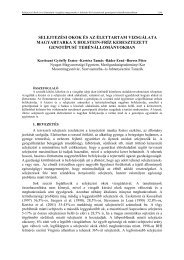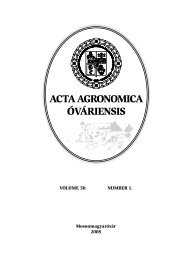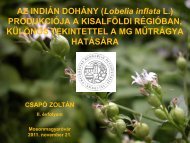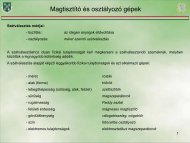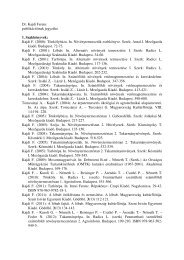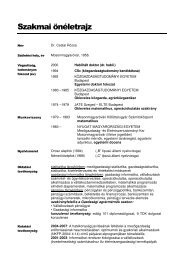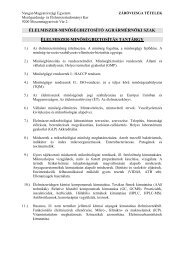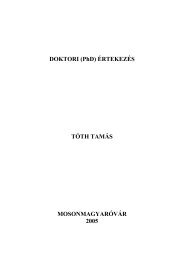22Cs. Gombkötô – J. Iváncsics:the meadow clay soils with middle hard character and the soils along the rivers. It canbe harvested at the end of June. By optimal growing technology the average yield ca beeven 15–20 t/ha.Sprint: it’s a hardnecked, french variety. Its scape with bulbils is 100–120 cm long inJune. That variety can be planted also by bulbils, which are between the flowers of garlic(Becker-Dillingen1956). The foliage is rich. Its leaves are 80–90 cm high, and wide. Itsbulbs have huge size, and the cover is lilac striped. The variety has a fast shooting, anda vigourous increase, because of this can be perished by freezing in Hungary. We canavoid this by planting at the latest time as possible (middle-, end of November), and/orwe use mulch. The dormancy of the cloves is very short. From the examined varietiesthe Sprint was harvested the earliest: in optimal environmental conditions already on theprime–middle of June. 1–2 weeks before the harvest it’s expedient to break the scape, sowe can get better yield. Beside the distinguished average yield it is shorter time storable,than the others winter garlic.Thermidrome: it belongs to the Allium sativum var. sativum also, it’s a french variety.The foliage is rich, with medium-green letters. The bulbs are big, 50–60 g, with regularforms. The cover is white, with pale pink patches. On all of the area of Hungary can besuccessfully cultivated, because it tolerates the extreme areas. It can be planted also inautumn and in spring, but only the case of autumn planting gives bigger crop. It can beharvested at end of the June at the same time as the variety Makói ôszi.Arno: it’s a French softnecked garlic. Its foliage is not exaggeratedly rich, with a deepgreen colour. Its large bulbs are standing on more clove circles, it has numerous cloves(15–20 pieces) with a longish form. The colour of the cover is pinkish-white. The shootingis slow: needs at least 8–10 week in the meteorological conditions of Hungary. The varietyoverwinters very well, the danger of freezing is small. It can be harvested somewhat lateras the other winter garlics, soon early, middle of July. Its yield can even reach 10–12 t/ha.Its beneficial characteristic is, that it’s storable for a long time.Vernal kind: GK Lelexír (= Makói tavaszi): state-recognized, Makó garlic. It was improvedwith clone selection from a landscape variety. It belongs to the softnecked garlics(Alliumsativum convar.sativum). It has lower growth (40–50 cm) than the Makói ôszi, its foliageis thinner, has middle-green coloured leaves. The cloves stand in a bulb with 30–50 gweight, and those one are surrounded by white coloured closed covers. It must be plantedas early as possible in March, so the yield can be 10–15 t/ha. We can get round to theharvesting early–middle of July. Its beneficial characteristicis, that it’s excellently storable(even next year April–May), and its seasoning value is over the average (Iváncsicsand Gombkötô 2007).RESULTSOur experiments were set in Hanságliget, the type of the soil was peat meadow soil.Meadow soils which can be found in Hanság are old moorland bottoms, from which ones
Hungarian and french garlic varieties’ vegetative growing on the country of Hanság23the peaty stratas were carried away by the wind and only the clayey stratas were left. Thehigh underground water-level ensures the favorable water supply of the vegetation helpwith this the quick and rich growth of the plants. The humus is black coloured and sticksthe grains of soils to Polyhedron form together (Stefanovits 1956).Based on the soil survey results of nutrient planning we strewed onto the area N:P:K =120:100:150 kg/ha of agent.Garlic plants respond to day length and form a bulb under long days, regardless of theplant’s size. (Splittstoesser r 1990). We have planted the varieties in the following times:– Winter varieties: 7–10 October,– GK Lelexír (Makói tavaszi): 10–12 March.The depth of the planting by the winter varieties were 7–8 cm, by the spring varieties 4–6cm. Line width x stem distance = 30 cm x 8–12 cm, depending on that exterior,- inside, ormiddle cloves were planting. In the case of the cloves from the exterior circle we used abigger stem distance (12 cm), because these can develop bulbs with bigger mass, and withmore cloves. Opposite this by the middle cloves of the bulb we planted on a smaller stemdistance (8 cm). At first the observed varieties were involved in an examination based onthe shooting vigour and the winter increase intensity. We evaluated shooting percentagemore times together with the examination of the plant altitudes. Between the examinedvarieties the cloves got to evaluation based on the position of the cloves inside the bulb(exterior, middle and inside cloves). The examination of shooting percentage was madeby us with linear metre measuring, in a four repetitions of random block arrangement. Wedefined the number of plants of the linear metres. The growing intensity was evaluatedby assigned 10–10 plants, measured the altitude from the ground with mm accuracy infour repetitions.Table 4. shows the dates of harvests. The data process was made with the spreadsheetprogram Microsoft Excel. We set the average values of the measured results in a table, andcolumn on a diagram, or we illustrated it on a line graph. The received values was evaluatedby one-way analysis of variance at a P 5% probability level, and by the measurementof the mass of the bulbs we used Two sample t-test variance analysis at a P 5% probabilitylevel. (Sváb 1973).Table 4. Dates of the harvestsSprint 07 June 2007Thermidrome 15 June 2007Makói ôszi 20 June 2007Arno 06 July 2007GK Lelexír 15 July 2007




